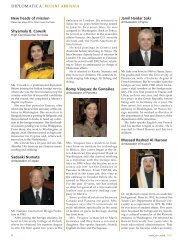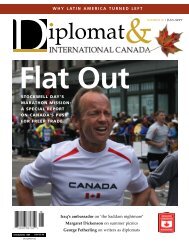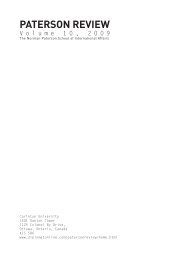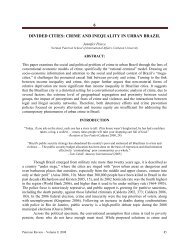Di spatches|refugeesDabaab’s dilemmaKenya’s refugee camps, the largest in the world, are overcrowded. What to do?By Chantaie AllickUNHCR / B. BannonParalyzed by polio, Muktar, a 31-year-old father of five, is relocated by donkey cart from a temporary settlement into a new tent.More than 100,000 Somalis havefled to Kenya in the past sixmonths to escape a droughtand famine that has decimated the EastAfrican country. They trek across barren,drought-ravaged, sand-covered land inblowing wind to do so.Then, they arrive at Dadaab, an overcrowdedsettlement made up of dirtpathways, administrative buildings, large,self-sustaining markets and tin-roofedshacks and tents in neat rows surroundedby thick wood fences made of branches.Children run around, and goats wanderthe open spaces dotted with thin-limbedtrees where some of the town’s brownskinnedinhabitants have spent theirlifetimes.For the past 20 years, in the desert-likeborder region of the eastern part of Kenya,a strange settlement of stateless Somalishas established an uncertain existence inthe Dadaab refugee camps: lives spentin exile. The camps are the largest andmost overcrowded in the world. At thebeginning of 2011, the settlement, built for90,000, had more than 300,000 refugeescompeting for space and resources.The complex was built in 1991 to houserefugees from the Somali civil war. Afterthe initial mass arrival in 1991 and 1992, asteady inflow of Somalis has continued toarrive at the settlement, which is made upof three camps set up with mud houses,open markets, schools, administrativebuildings and borehole wells on an openswath of land provided by the Kenyangovernment. Desperate women and childrenhave walked for days to reach theshelter and food provided by the UnitedNations High Commissioner for Refugees(UNHCR).In 2011, the camps received 140,000refugees, almost half of them in June andJuly alone. The UNHCR expected that,by year’s end, more than 500,000 peoplewould be crammed into a space meant tohouse less than one-fifth of that number.Improvements made at the camps overthe years are now being overwhelmed bythis mass influx. Better shelter, sanitation,food distribution, policing and protectionhave all been sacrificed, while riots, rapeand insecurity have once again becomethe norm.Some had to wait days in the earlyhours of the emergency for food or assistance.Many fell through the cracks. Somedied.An expansion of the camps, planned toaddress the original overcrowding, is nowbeing filled with rows of white UNHCRtents to accommodate the new arrivals.58WINTER 2012 | JAN-FEB-MAR
efugees|Di spatchesUNHCR / B. BannonA relocated family builds a tukul next to their new tent to shield against the mid-day sun.Aid workers worry about running out ofwater; in some areas of the camps, 1,250people share one tap.Lessons have emerged from 20 years atDadaab, where what began as a temporarysolution has spanned generations.Overcrowding wouldn’t be an issue ifnot for the protracted situation that hasbeen left to fester. Dr. James Milner, aCarleton University expert in refugee issues,says: “The idea of simply providinghumanitarian assistance to refugees incamps is not going to lead to a solution.”Dr. Milner sees three options: repatriation,resettlement or local integration. But a returnto Somalia through repatriation isn’ta realistic option for Somali refugees andresettlement to another country wouldhave been more easily done before Sept.11, 2001.Local integration of refugees intoKenyan society may, however, be amore viable option. It would require theKenyan government to offer citizenship(or another form of legal status) for refugeesin much the same way that Tanzaniadid in 2010. This would allow refugees<strong>freedom</strong> to move beyond the confines ofthe camps, permitting them to work andto contribute to Kenyan society. While theKenyan constitution has been amendedto allow for this solution, the political willdoesn’t exist to implement it.Kenya has a long, problem-fraught historyof hosting Somali refugees. Securityconcerns have caused the government toadopt a policy of containing refugees inthe camps. Kenya has often been laudedfor its willingness to allow the refugeesinto the country, but without the <strong>freedom</strong>to leave the camps, the refugees have fewoptions.Dr. Milner says the current crisis is anopportunity to make Kenya, which haslong abdicated all responsibility to theUNHCR, a full partner in dealing withrefugee issues. Given the circumstancesin Somalia, it’s more than probable thatKenya will continue to host its refugeesfor many years.Security problems are not a new phenomenonin refugee camps, but decidinghow to deal with them in the future hasto include lessons from what has workedin the past.With this latest influx of people, andthe subsequent scarcity of resources, securityhas once again become an issue atDadaab. But more policing isn’t the onlyanswer. In fact, according to Dr. Milner,it isn’t a matter of simply increasing thenumber of officers. Nuanced and innovativeresponses are needed — what Dr.Milner calls “targeted interventions.” Bettertraining for police officers has workedin the past. As well, the UNHCR hasemployed counselors to help the victimsof crime.The UNHCR and other aid organizationshave been warning of a crisis inthe region for several years, says WilliamSpindler, a UNHCR spokesman inDadaab. Still, the world was unpreparedfor what happened. “The infrastructure isin place,” he said, “but what caught everyoneby surprise was the number of peoplewho arrived in such a short period.”Famine and drought were once problemscontained within a country’s borders,he explained. As environmental disastersbecome more common, mass movementacross borders may as well. The worldneeds to be prepared with funds, food andsupplies.Yet the UNHCR doesn’t have a permanentbudget. Instead, each year it appealsto governments for handouts. Each year,the organization must raise 95 percent ofits budget.In its final 2011 global appeal, theUNHCR budgeted $223 million for operationsin Kenya. The influx of refugeesduring the year led to a budget shortfallof between 20 percent and 40 percent. It’sdifficult to budget for unexpected disasters.An operating budget would makeit easier. Indeed, the financial pressure isnot only about more money – but, rather,about being able to spend funds as neededrather than as directed by donor countries.According to Alexandra Lopoukhine,who works with Care Canada (theUNHCRs main partner on the groundin Dadaab), the solution here is to usepermanent funds to merge emergencyresponse with development initiatives inthe camps — including the cost of highereducation. Those permanent funds wouldhelp support development projects withinthe camps. They could, for example, beused to introduce new farming techniquesthat would help refugees produce theirown food and lower their dependence onthe agency for day-to-day survival. Thatin itself would go a long way to solvingmany of the issues in the camps. Thiscould include working with the UnitedNations Development Program to increasewater and food supplies.All of the experts agree that findingsolutions for Dadaab, and for those wholive there, is complicated. If solutions hadbeen sought more aggressively in the past,rather than letting the Somalis languish inthe stateless life of UNHCR handouts, thecamps would have been at least partiallycleared out and better able to accommodatethe latest influx. Alas, millions of aiddollars have been put into Dadaab and yetthe world is no closer to a long-term solutionfor the camps’ inhabitants.Chantaie Allick is a reporter and writerbased in Toronto.diplomat and international canada 59
















